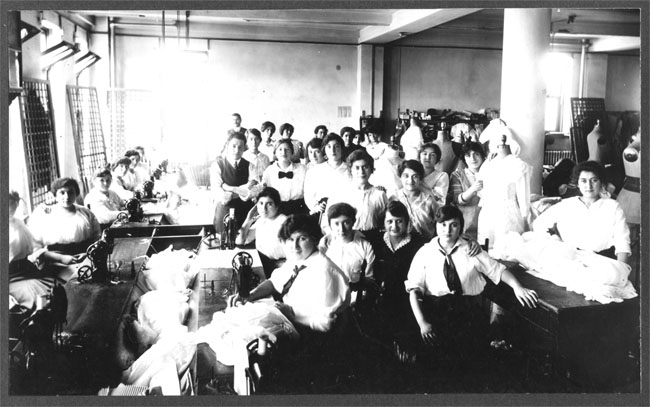
After finding homes on the Lower East Side newly arrived Jewish immigrants often went to work in the garment industry. As the 19th century came to a close and industry developed, hand sewing gave way to sewing machines, sweatshops and factories in need of workers to quickly turn out new and in-vogue ready-to-wear clothes. Prior to industrialization in New York City, clothes were often custom made at a home and unless the wearer was part of the upper class and could hire a tailor, the item was made by the wearer or their family member. With the rise of factories this changed: ready made clothes became immensely popular, and were marketed to not only the upper class but the middle and poorer classes as well.1 New immigrants who made the clothes were also able to buy them, so the garments they made became a mechanism for immigrants’ Americanization. As New York City garment production grew and expanded in the early 20th century, manufacturing moved away from sweatshops – apartments or tenements where workers would be contracted out and gathered in the cramped spaces and to sew clothes – to new modern factories further uptown.2 Factories often had the most modern technology and electricity. Despite this modernity and efficiency, the conditions for the workers remained poor. The great majority of garment industry workers were new Jewish or Italian immigrants, who were viewed as the Other and not-American, and their labor was seen as dispensable. However, the clothes they made shaped American fashion, culture and society in the early 20th century.

Jewish immigrants worked for long hours and little pay to produce as many garments as possible in sweatshops and factories. They worked alongside earlier arrivals who were more versed in American society and other immigrant workers, often from Italy, who exposed new Jewish immigrants to new ideas and contributed to their acculturation in United States society. Rose Cohan writes in her autobiography, that when she first arrived in the United States to join her father who had been there a few years, she noticed “when he went away in the morning it was still dark, and when he came home at night the lights in the halls were out. It was after ten o’clock.”3 When she went to work in a factory she too discovered the hard work of sewing for long hours. Rose Cohan describes the hectic and even frantic atmosphere of the noisy factory as everyone worked as quickly as they could. The factory boss would give her “only two coats at a time to do,” she writes, “when I took them over and as he handed me the new work he would say quickly and sharply, ‘Hurry!’”4 Rose Cohan also tells how she was employed only by the week and paid $3 to do piece work – workers were paid for the amount of clothing they produced as opposed to being paid a fixed weekly rate.5 Sadie Frowne, another Jewish immigrant worker, details her experiences of the chaotic rush of a garment factory, in an article appearing in the Independent on September 25, 1902. She tells of the early mornings, large piles of fabric waiting to hastily be made into clothes and her $7 a week salary.6 “The machines go like mad all day because the faster you work the more money you get” she describes.7

The factories were often dangerous and accidents frequently happened in the rush. “Sometimes in my haste I get my finger caught and the needle goes right through it… I bind the finger up with a piece of cotton and go on working. We all have accidents like that” tells Sadie Frowne.8 In a piece first published in the New York Evening Journal on November 28, 1909, Clara Lemlich, a 23 year old Jewish immigrant garment worker turned labor activist describes these unsafe conditions and unfair treatment of workers in the factories.
There is just one row of machines that the daylight ever gets to – that is the front row, nearest the window. The girls at all the other rows of machines back in the shops have to work by gaslight, by day as well as by night…The shops are unsanitary – that’s the word that is generally used, but there ought to be a worse one used. Whenever we tear or damage any of the goods we sew on, or whenever it is found damaged after we are through with it, whether we have done it or not, we are charged for the piece and sometimes for a whole yard of the material.9
Her account tells of the frustration and the grievances she had for her working conditions, a sentiment that was shared with many other workers.
1. Andrew Godley, “The Development of the Clothing Industry: Technology and Fashion,” Textile History 28, (1997): 8. https://doi.org/10.1179/004049697793711067.
2. Michael Keene, with Hasia R. Diner, “The Triangle Shirtwaist Factory Fire,” Podcast. Talking Heart Island, 2019. https://talkinghartisland.podbean.com/e/the-triangle-shirt-waist-factory-fire-with-hasia-diner/.
3. Rose Cohan, Out of the Shadow: A Russian Jewish Girlhood on the Lower East Side, Documents in American Social History (Ithaca, NY: Cornell University Press, 1995), 74.
4. Ibid., 112.
5. Ibid., 112.
6. Sadie Frowne, “Days and Dreams,” Trianglefire.Ilr.Cornell.Edu, 2018. https://trianglefire.ilr.cornell.edu/primary/testimonials/ootss_SadieFrowne.html.
7. Ibid.
8. Ibid.
9. Clara Lemlich, “Life In The Shop,” Trianglefire.Ilr.Cornell.Edu, 2018. https://trianglefire.ilr.cornell.edu/primary/testimonials/ootss_ClaraLemlich.html.